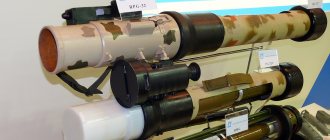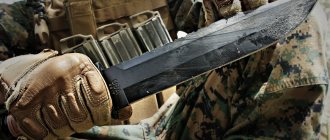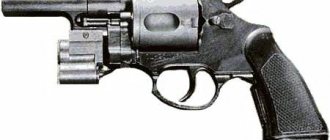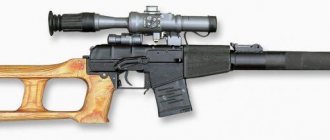AGS-17 Flame automatic grenade launcher developed at KBTM named after. Nudelman, and its production was established at the Vyatsko-Polyansky Machine-Building Plant. It is designed to destroy enemy personnel and fire weapons located outside of shelters and behind natural folds of the terrain (ravines, hollows, reverse slopes of heights), etc. In the Russian Army, the AGS-17 is used not only from a machine gun.
AGS-17 Flame – video
There is an aviation (helicopter) version with an electric trigger, which also differs from the infantry one in having a massive aluminum muzzle for more efficient cooling of the barrel during intense shooting. The AGS-17 is installed with the same muzzle in a turret mount on armored boats, but with a conventional mechanical release device. AGS-17 is used in remotely controlled installations used in the creation of fortified areas. Recently, a number of promising domestic models of armored vehicles have appeared, where the AGS-17 is mounted on a turret.
During the fighting in Afghanistan, AGSs were often welded to the armor of armored personnel carriers or infantry fighting vehicles, significantly increasing the firepower of the equipment, which made it possible to “get” the enemy in conditions when standard weapons turned out to be ineffective. Such an improvised complex in the mountains was especially helpful.
In fact, the AGS-17 “Plamya” easel grenade launcher is a miniature artillery gun and is served by a crew of two people, one of whom directly controls the fire, and the second brings ammunition, helps transport the grenade launcher and move it on the battlefield when changing firing positions, etc. d. For firing from a grenade launcher, 30-mm VOG-17, VOG-17M and VOG-30 rounds are used. The shot is a unitary cartridge consisting of a grenade with a fuse and a cartridge case with an igniter primer and a powder charge.
The grenade launcher is fed with ammunition when firing from a metal belt for 29 rounds, placed in a box, which in the firing position is attached to the right side of the grenade launcher. The USM allows you to fire both single shots and bursts. Firing from a grenade launcher can be carried out in both flat and mounted trajectories. Experience in combat operation of the AGS-17 has shown that the most effective is firing in short bursts of 3-5 shots. In this case, an experienced grenade launcher is able to adjust the fire based on the explosions of the first grenades and reliably hit the target, spending a minimum amount of ammunition. Maximum firing range 1700 m.
The AGS-17 grenade launcher (automatic grenade launcher) is installed on the SAG-17 tripod machine (automatic grenade launcher machine). For shooting, a mechanical sight is used, consisting of a rear sight and a front sight mounted on the receiver cover, or a PAG-17 prismatic optical sight (automatic grenade launcher sight). The mechanical sight is used when firing direct fire at a distance of up to 700 m. The optical sight is a universal sighting device and provides guidance to the grenade launcher when firing direct fire and from closed positions. If the size of the target is known, the distance to the target can be determined using the sight.
The operation of the automatic grenade launcher is based on the principle of using the recoil energy of the free shutter. When fired, the powder gases press on the bottom of the cartridge case and throw the bolt to the rearmost position. In this case, the return springs are compressed, the next cartridge is supplied to the dispensing line to the entrance window of the grenade launcher and the spent cartridge is reflected. When the bolt rolls back, the shot is sent into the chamber and the firing pin is cocked. By the time the bolt reaches its extreme forward position, the firing pin is disconnected from the bolt. The firing pin, moving backward under the action of the mainspring, hits the firing pin lever, and the firing pin pierces the igniter primer of the cartridge. A shot occurs.
The standard tape is made up of three separate pieces of 10 rounds each. The pieces of tape are connected to each other using shots and placed in a box. The first link remains empty, since when the grenade launcher is loaded, the belt advances one link and the first shot sent into the chamber is a grenade from the second link of the belt. Ribbon rigging can be done manually or using a rigging machine. In field conditions, the filling machine can be mounted on a packing box. If necessary, the machine can be used to unload the tape. The shot feed mechanism, located under the receiver cover, is driven by a bolt, on the upper surface of which there is a groove that forces the feed lever to move.
The AGS-17 grenade launcher consists of the following main parts and mechanisms: receiver, trigger mechanism, box with barrel, bolt, reloading mechanism, return springs. The box contains the main parts and details of the grenade launcher. A barrel with 16 right-hand rifling is inserted into the front part of the box (pipe). On grenade launchers produced before the beginning of the 90s, to improve cooling, the barrel was equipped with a relatively thin-walled aluminum muzzle (different from the aircraft version). Then this was abandoned, and the cooling radiator is a series of annular thickenings on the barrel, located closer to the breech.
At the rear of the box, a butt plate is attached to two axle shafts and an axle. Handles are attached to the lower axle shafts for aiming the grenade launcher at the target and holding it while firing. In the stowed position, the handles fold. On the outside of the buttplate there is a release trigger. In front of the left handle there is a fire mode translator, which has two positions - “AUTO.” (automatic fire) and “OD.” (single light). On the left and right cheeks of the box on the inside there are two guides along which the bolt moves: two copiers are riveted there - left and right, interacting with which the levers transmit movement to the reducer (aka rammer) located on the bolt, which ensures the supply of cartridges from tapes into the chamber of the barrel.
To mount the grenade launcher on the machine, there are two flanges on the box, as well as a bracket located in the lower rear part of the box. On the right side of the box there is a bracket with a latch riveted for attaching the cartridge box. On the left side of the box there is a bracket for installing an optical sight. The sight is equipped with two light filters - a neutral one to simplify aiming in bright sunny weather and an orange one to increase image contrast in cloudy weather. The aiming angle scale is made in the form of aiming marks (squares) and strokes up to a range of 700 m and is digitized after 100 m with numbers from 1 to 7. The division value between aiming marks is 100 m, and between aiming marks and strokes is 50 m. To the left and right of The central sighting mark contains a lateral correction scale.
Longitudinal and transverse levels are installed on the body of the optical sight to give the grenade launcher a given elevation angle and leveling of the grenade launcher. The sight is equipped with a front sight and a rear sight, which are used to roughly sight the grenade launcher at the target. The sight's reticle scales can be illuminated at night. For this purpose, a special cartridge is used, which is attached to the sight body. The batteries are placed in a case attached to the machine.
On the top plane of the massive bolt there is a curved groove into which the feed lever roller, a comb for activating the cartridge case reflection mechanism, and a hook for connecting the bolt to the reloading mechanism enter. There are three longitudinal blind holes in the body of the shutter. The two bottom ones are designed to accommodate return springs. The third hole acts as a hydraulic brake cylinder, which absorbs excess energy from the recoil bolt and slows it down when it comes to the forward position.
In the front part of the bolt, a reducer moves along vertical grooves, which, when the bolt rolls up, removes the shot from the link, lowers it and sends it into the chamber. There are two slots on the left side of the bolt; in the front there is a firing pin lever on the axis, which serves to transfer the energy of the firing pin to the firing pin, and in the rear there is a disconnector on the latch, designed to cock the firing pin and disconnect it from the bolt when the latter comes to the forward position.
The trigger mechanism is located on the left side of the box and is secured by the receiver axis. The mechanism is connected to the trigger through the trigger bar. The reloading mechanism is located under the box cover and is designed for loading and reloading the grenade launcher. To load, you need to pull the cocking handle, which is connected by a cable to the bolt cocking hook, back all the way and release it.
For firing, the grenade launcher is installed on the SAG-17 machine, which consists of two main parts - the upper machine and the lower machine. On the left side of the frame of the lower machine there is a bracket for attaching a case with batteries for the sight illumination system.
The upper machine is connected to the lower one by means of a swivel and a slider. The upper and lower cradles are located on the upper machine. The upper cradle, on the axles of which the grenade launcher is mounted, can rotate in a vertical plane on an axis connecting the upper and lower cradle. The latch located on the upper cradle serves to connect the cradle to the grenade launcher earring. The lower cradle serves to ensure horizontal guidance of the grenade launcher, as well as to accommodate the vertical guidance mechanism and clamp the vertical guidance sector.
Before loading, the parts and mechanisms of the grenade launcher occupy the following positions: the bolt is in the extreme forward position, the firing pin is on the sear, the sear is locked with a fuse, the receiver is closed, the reloading mechanism clip is connected to the bolt hook and is in the forward position. To load a grenade launcher, you must: pull the bolt back by the handle until it stops and release the handle. When the handle is pulled back, the clip moves the bolt back, compressing the return springs. The feed lever, interacting with the curvilinear groove of the shutter, feeds the first cartridge to the entrance window of the box.
After releasing the handle, the bolt moves forward under the action of springs. In this case, the levers, interacting with the box copiers, raise and then lower the reducer. The reducer grabs the first cartridge by the bottom of the cartridge case, removes it from the link, lowers it and sends it into the chamber. At this time, the feed lever is idling. When the bolt moves forward, the disconnector picks up the firing pin and cocks it, compressing the firing pin spring. When the bolt comes to the forward position, the left copier will disconnect the firing pin from the bolt, after which the firing pin, moving backward under the action of the mainspring, will stand on the sear. To fire a shot, you must move the safety to the “fire” position and press the trigger.
When you press the trigger, the trigger bar will move forward and, acting on the flag, turn the sear of the firing mechanism. The sear will disengage with the firing pin cocking. The firing pin, moving backward under the action of the mainspring, will strike the firing pin lever with its front tooth. The firing pin lever will rotate on its axis and with its second shoulder will strike the firing pin, which will puncture the primer. There will be a shot.
Simultaneously with the start of the grenade moving along the barrel, the bolt begins to roll back, the return springs are compressed, and the feed lever turns. The feeder supplies the cartridge to the entrance window of the box. At the beginning of the rollback, the hydraulic brake rod moves together with the bolt. After the rod flange rests against the butt plate, the hydraulic brake comes into operation. The kerosene in the hydraulic brake cylinder is forced from the front of the cylinder to the rear. The shutter is braking.
When the bolt moves backward, the reducer rises under the action of the levers and releases the upper edge of the sleeve rim. At the same time, the sleeve rests against the front bevel of the reflector, which is stationary at this moment, the lower edge of the cap, coupled with the combat plate extractor, continues to move backward; the sleeve tilts. As the shutter moves further, its ridge lifts the rear shoulder of the reflector and rotates it. The front shoulder of the reflector hits the inclined sleeve and throws it outside the box. After the cartridge case has been deflected and the cartridge strip has finished feeding, the remaining bolt energy is absorbed by the hydraulic brake and return springs.
AGS-17 main parts and mechanisms
When the bolt rolls up, under the action of the return springs, the bolt captures the next shot with the reducer, removes it from the link, lowers it and sends it into the chamber. The feed lever is idling. At the end of the idle stroke, the feeder comes in for another shot. The hydraulic brake rod first moves with the valve and then stops with stops located on the box. The kerosene located in the rear part of the hydraulic cylinder is forced out by the piston to the front part. When rolling forward, the disconnector grabs the firing pin by the rear tooth and, squeezing the mainspring, cocks it. When the bolt comes to the front position, the firing pin is disconnected from the bolt.
The firing pin, moving backward under the action of the mainspring, strikes the firing pin lever with its front tooth. The lever, turning on its axis, strikes the firing pin with its second shoulder. The firing pin breaks the igniter primer. A shot occurs. Then the work cycle is automatically repeated (with the translator position “AVT”). In order to stop shooting, you must release the trigger. In this case, the drummer will stand on the sear.
In general, the design of the grenade launcher ensures reliable operation of the weapon in any operating conditions, and the AGS-17 “Plamya” still surpasses similar foreign systems in most characteristics.
VOG-17 shot for the AGS-17 grenade launcher
The main purpose
The list of tasks that are successfully solved using various grenade launchers speaks for itself:
- Destruction of all types of moving small targets (tanks, armored vehicles, infantry fighting vehicles, trucks, river and sea boats, etc.);
- Suppression and destruction of fortified firing points (bunkers, armored caps, pillboxes and simply machine gun nests);
- Defeat enemy fire weapons and manpower located both in open areas and in trenches, as well as on reverse slopes and in ravines;
- Fight against low-flying enemy aircraft, primarily fire support helicopters.
UH-60 "Black Hawk", shot down in Mogadishu in October 1993. The Americans believe that the helicopter was destroyed by a shot from a grenade launcher.
Of course, there are no grenade launchers that would be able to solve all these problems equally successfully. Each of the subtypes of these weapons has its own specialization.
Modifications
AGS-17 “Flame” (GRAU index - 6G11, grenade launcher index with machine - 6G10, designation KB 216P) - the basic infantry version on the SAG-17 tripod machine. During the war in Afghanistan, it was often installed in the entrance doorway of a Mi-8T helicopter;
AP-30 "Plamya-A" (also AG-17A, developer index - 216P-A, Air Force UV index - 9-A-800) - an aviation version, differing from the basic one by an electric trigger, a shot counter reduced from 715 mm to 600 mm rifling pitch in the barrel due to the increased speed of the grenade when firing from a helicopter and increased to 420-500 rounds/min. rate of fire and, accordingly, a massive radiator cooling the barrel during more intense shooting. Developed according to the resolution of the Central Committee of the CPSU and the Council of Ministers of the USSR No. 1044-381 of December 26, 1968, adopted for service in 1980.
AG-17D - variant, installed in the Terminator BMPT
AG-17M is a naval modification equipped with an enlarged barrel radiator. Installed in turret installations on boats, as well as in a directional installation on the BMP-3.
KBA-117 is a Ukrainian version created by the Artillery Armament Design Bureau, designed for installation on the combat module of armored personnel carriers and armored boats. At the beginning of 2014, development of an infantry version began.
Zastava M93 (Zastava BGA 30 mm) is a Serbian 30-mm grenade launcher, a copy of the Soviet AGS-17.
Design of the SLW AGL automatic grenade launcher
The compactness of the SLW AGL grenade launcher is achieved through the use of an automatic operating principle that is non-standard for this class of weapon using ammunition energy. In this case, when a grenade is fired, due to the frictional force, it pushes the barrel forward, and the recoil force pushes the bolt back. However, the recoil length of the bolt is insignificant compared to systems operating on the principle of using the recoil energy of the bolt, so the length of the SLW AGL receiver, and therefore the entire length of the weapon, was significantly reduced compared to other models.
To significantly (almost halve) reduce recoil, weapon creators use a patented differential recoil system. The SLW AGL bolt is too small and has insufficient recoil length to provide enough counterweight to the forward movement of the barrel to effectively absorb recoil. Therefore, in the design of the weapon, according to the developers’ terminology, an “inertial countermass” was introduced, located above the barrel and externally looking like an overhanging gas outlet tube. Naturally, the creators do not go into details of the design, but one can imagine that the “counter-mass” is a hydraulic, pneumatic or spring system of buffers and shock absorbers, designed not only to absorb recoil, but also to return the barrel back to its original state after it has been completely rolled out.










